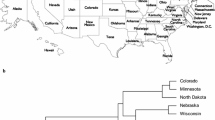Abstract
An outbreak of rust on Salix × mollissima (S. triandra × S. viminalis) ‘Q83’, an important biomass willow, was first observed at several locations in the UK in 1992. Rust collections obtained from ‘Q83’ in 1992 at Long Ashton (south west England), Markington (Northern England) and Loughgall (Northern Ireland), were tested for pathogenicity and examined using amplified fragment length polymorphism (AFLP). All collections showed the same pathogenicity patterns on the eight willow differentials and were assigned to f.sp. larici-epitea typica of Melampsora epitea. A total of 304 AFLP markers was scored for 54 rust isolates, 20 from Long Ashton, 20 from Markington and 14 from Loughgall. Cluster analysis placed the isolates into three distinct groups according to the collection sites. Within each site, Markington isolates were least variable, Nei & Li's similarity coefficients averaging 0.996. Average similarities within isolates from Long Ashton and Loughgall were 0.899 and 0.883, respectively. Average per-locus diversity within site (Hj′), calculated using Shannon information index, was 0.014 in Markington, 0.24 in Long Ashton and 0.23 in Loughgall population. Most diversity (69.1%) was partitioned between populations. An analysis of molecular variance (AMOVA) attributed 85.8% of variance to between populations and 14.2% to the individuals within populations. The results suggest that, in 1992, this previously unknown pathotype was not spread from a common source but from separate sources. The AFLP analysis and early records on the host range of M. epitea indicate that the rust virulent to S. × mollissima may have existed in nature before 1992.
Similar content being viewed by others
References
Bean WJ (1973) Trees and Shrubs Hardy in the British Isles, Vol. II, 8th edn. John Murray Ltd., London, UK
Bobart HH (1936) Basketwork through the ages. Oxford University Press: Oxford, UK
Bussell JD (1999) The distribution of random amplified polymorphic DNA (RAPD) diversity amongst populations of Isotoma petraea (Lobeliaceae). Molecular Ecology 8: 775–789
Excoffier L, Smouse PE, and Quattro JM (1992) Analysis of molecular variance inferred from metric distances amongDNA haplotypes: application to human mitochondrial DNA restriction data. Genetics 131: 179–191
Fritz RS, Johansson L, Åstrom B, Ramstedt M and Häggström H (1996) Susceptibility of pure and hybrid willows to isolates of Melampsora epitea rust. European Journal of Plant Pathology 102: 875–881
Hunter T, Royle DJ and Arnold GM (1996) Variation in the occurrence of rust (Melampsora spp.) and other diseases and pests, in short-rotation coppice plantations of Salix in the British Isles. Annals of Applied Biology 129: 1–12
Kent M and Coker P (1994) Vegetation Description and Analysis: A Practical Approach. John Wiley and Sons Ltd., Chichester, UK
Klebahn H (1899) Kulturversuche mit heteröcischen Rostpilzen. Zeitschrift für Pflanzenkrankheiten 9: 88–99
Latch BJ (1980) Weeping willow rust in New Zealand. New Zealand Journal of Agricultural Research 23: 535–538
Li WH (1997) Molecular Evolution. Sinauer Associates, Inc., Sunderland, Massachusetts, USA
Meikle RD (1975) Salix L. In: Stace CA (ed) Hybridization and the Flora of the British Isles (pp 305–338). Academic Press, London, UK
Meikle RD (1984) Willows and Poplars of Great Britain and Ireland. BSBI Handbook 4. Botanical Society of British Isles, London, UK
Monagahan BG and Halloran GM (1996) RAPD variation within and between natural populations of morama (Tylosema esculentum (Burchell) Schreiber) in southern Africa. South African Journal of Botany 62: 287–291
Nei M and Li WH (1979) Mathematical model for studying genetic variation in terms of restriction endonucleases. Proceedings of the National Academy of Sciences of the USA 76: 5269–5273
Parker SR, Royle DJ and Hunter T (1993) Impact of Melampsora rust on yield of biomass willows. P. 117. In: Abstracts of the 6th International Congress of Plant Pathology, Montreal, Canada, 28 July-6 August 1993, National Research Council Canada, Ottawa, Canada
Pei MH, Royle DJ and Hunter T (1993) Identity and host alternation of some willow rusts (Melampsora spp.) in England. Mycological Research 97: 845–851
Pei MH, Royle DJ and Hunter T (1996) Pathogenic specialization of Melampsora epitea var. epitea on Salix. Plant Pathology 45: 679–690
Pei MH, Hunter T and Ruiz C (1999a) Occurrence of Melampsora rusts in biomass willow plantations for renewable energy in the United Kingdom. Biomass and Bioenergy 17: 153–163
Pei MH, Royle DJ and Hunter T (1999b) Hybridisation in larchalternating Melampsora epitea (M. larici-epitea). Mycological Research 103: 1440–1446
Pei MH and Ruiz C (2000) AFLP evidence of distinct patterns of life-cycle in two forms of Melampsora rust on Salix viminalis. Mycological Research 104: 937–942
Roelfs AP (1984) Epidemiology in North America. In: Roelfs AP and Bushnell WR (eds) The Cereal Rusts Vol II, Disease Distribution, Epidemiology and Control (pp 403–434) Academic Press, Orlando, USA
Sneath PHA and Sokal RR (1973) Numerical Taxonomy W.H. Freeman and Company, San Francisco, USA
Stott KG (1992) Nomenclature of the promising biomass coppice willows, Salix × sericans Tuasch ex Kern., Salix dasyclados Wimm. and Salix 'Aquatica Gigantea'. Botanical Journal of Scotland 46: 137–144
Vos P, Hogers R, Bleeker M, Reijans M, van de Lee T, Hornes M, Frijters A, Pot J, Peleman J, Kuiper M, and Zabeau M (1995) AFLP: a new technique for DNA fingerprinting. Nucleic Acid Research 23: 4407–4414
Wilson M and Henderson DM (1966) The British Rust Fungi Cambridge University Press, Cambridge, UK
Zadoks JC and Bouman JJ (1984) Epidemiology in Europe. In: Roelfs AP and Bushnell WR (eds) The Cereal Rusts Vol II, Disease Distribution, Epidemiology and Control (pp 329–369). Academic Press, Orlando, USA
Author information
Authors and Affiliations
Rights and permissions
About this article
Cite this article
Pei, M., Yuan, Z., Hunter, T. et al. Heterogeneous Nature of a ‘new’ Pathotype of Melampsora Rust on Salix Revealed by AFLP. European Journal of Plant Pathology 106, 771–779 (2000). https://doi.org/10.1023/A:1026593119871
Issue Date:
DOI: https://doi.org/10.1023/A:1026593119871




